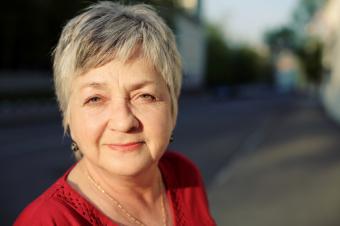
Wrinkles occur when the skin's natural moisture barrier diminishes. This is a natural occurrence that accompanies aging. Understanding this process and how to slow the signs of aging may help you to maintain a youthful complexion over time.
Why We Get Wrinkles
Young skin is stretchy. A fiber called elastin is responsible for young skin's elasticity, or its ability to spring back into shape. Another molecule, a protein called collagen, helps keep skin looking plumped up and youthful. A layer of fat beneath the skin also keeps it looking smooth.
As you age, skin begins to lose collagen and elastin. It can't bounce back the way it used to. The fat layer begins to thin out, too, which reduces the amount of support below the skin. Older skin is drier and produces less oil than young skin. All of these things contribute to wrinkled skin.
Risk Factors
Although everyone gets them eventually, some people begin to see this tissue collapse sooner than others. Some people first notice them in their 20s or 30s; others won't start to have them until their 50s or 60s. Why do some people seem to age more quickly?
- Sun exposure: Sun exposure is a big risk factor. The sun's ultraviolet rays damage collagen and cause abnormal elastin to form.
- Smoking: Chemicals in cigarette smoke slow down the production of collagen.
- Family history: Patterns and timing of skin aging are often inherited.
- Skin color: Light-skinned people tend to show sun damage and develop lines earlier than people with darker skin.
Prevention
There is no way to prevent wrinkling completely. However, people who take good care of their skin seem to have fewer of them, or at least develop them later. Taking basic anti-aging skin care prevention measures can help reduce and delay age related skin problems.
- Stay out of the sun: Wear protective clothing, including hats that block the sun and sunglasses with a high level of UV protection. Use a good sunscreen every day, on all exposed skin. Women can also use protective makeup or moisturizer.
- Moisturize: Since older skin has trouble retaining moisture, moisturizing can help to delay wrinkles or minimize their appearance.
- Quit smoking: Quitting is good for your whole body, not just your skin.
- Relax: Lines between the eyebrows or that extend from the eyes are intensified by the small muscle contractions that go with being worried or stressed.
Anti-Wrinkle Creams
The skin care aisle at the drugstore is filled with anti-wrinkle creams, and treatments are available by prescription, too. Here are some of the more popular ingredients in anti-aging skin care products:
- Tretinoin: Tretinoin is a vitamin A derivative, available by prescription, that helps improve skin's texture, tone, and color. Retinol is a similar but less potent medication available in over-the-counter creams.
- Alpha-hydroxy acids: Alpha-hydroxy acids (and beta- and poly-hydroxy acids) are derived from fruit. These acid help remove the top layer of old, dead skin cells and also stimulate the production of collagen.
- Vitamin C: Vitamin C is an antioxidant which helps protect the skin from sun damage. It may also stimulate collagen production. Many formulations of vitamin C break down when exposed to air, so over-the-counter treatments may not actually do much good. A dermatologist can recommend a good product.
- Coenzyme Q10: Co-Q10 is a naturally occurring molecule found in skin cells. It may help with wrinkles, although it's not clear how well it really works or what its long-term effects might be.
- Vitamin E. Vitamin E is an antioxidant. Skin loses vitamin E as it ages, but it's not clear if this has anything to do with lines or crow's feet.
Skin Resurfacing and Other Treatments
Dermatologists and plastic surgeons have developed several procedures to help remove wrinkles and make skin look younger. These wrinkle treatment procedures are popular and can work very well. However, they all can have serious side effects and should be performed only by a physician. Your doctor should give you a clear understanding of the risks and benefits.
Dermabrasion
Dermabrasion removes the top layer of skin, which allows smoother, younger-looking skin to grow. Microdermabrasion is a gentler version that removes a thinner layer and has a shorter recovery period, but does not work for deep or pronounced lines.
Chemical Peels
Chemical peels can be superficial, moderate, or deep. Which one to choose depends on the extent of skin damage, the type of skin, and other factors. Deep peels are rarely used, because they can be dangerous and are likely to cause scarring. Recovery time depends on the depth of the peel, and ranges from a few days to a few weeks.
Lasers
Laser resurfacing removes the top layer of skin using a special, concentrated light. Recovery can take several weeks.
Non-ablative lasers work on deeper layers of skin, without removing the top layer. Recovery is brief, but the results may be less dramatic than with resurfacing techniques.
Thermal Resurfacing
Thermal resurfacing uses radio frequency energy to tighten the deep layers of skin. It seems to work best on people who are just beginning to notice wrinkles.
Injections
Botox is an expensive but popular option. A dilute version of the paralyzing botulinum toxin, it reduces lines by temporarily paralyzing tiny muscles in the face. Other injections include collagen and artificial gels which "fill in" lines, smoothing them out by plumping up the skin beneath. Injections are temporary, lasting from a few months to a year or so.
Caring for Your Skin
Mature skin doesn't have to be excessively wrinkled. With regular skin care and some lifestyle changes, you may be able to maintain the youthful appearance of your skin. Be proactive, but don't obsess over small lines - these are natural. Your overall skin health is more important than a few perceived cosmetic imperfections.







